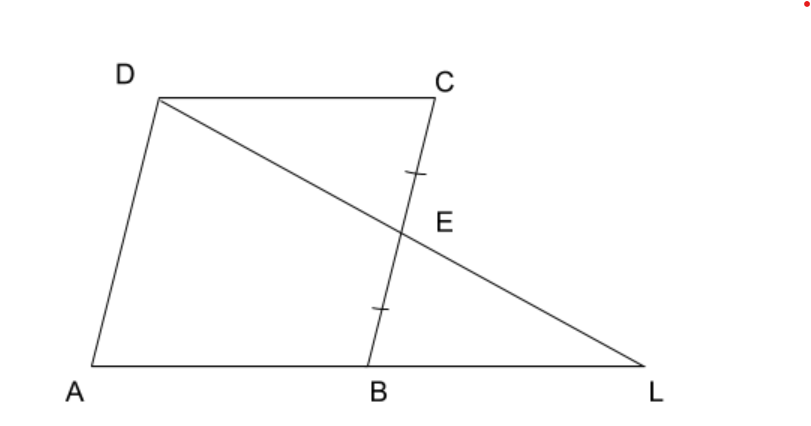
From the given diagram, in which ABCD is a parallelogram, ABL is a line segment and E is midpoint of BC. Hence, AL=2DC. If the above statement is true then mention the answer as 1, else mention 0 if false.


Answer
600k+ views
Hint: We will use basic properties of a rectangle or square and the basic properties of angles such as the property of vertically opposite angles as well as the property of alternate angles in order to solve this question.
Complete Step-by-Step solution:
Since it is given in the question at ABCD is a parallelogram and E is the midpoint of BC, we will jump to the triangles CED and BEL-
So, in ∆CED and ∆BEL we have,
$\angle CED = \angle BEL$ (By the property of vertically opposite angles)
Now, on CB side of the rectangle we know that-
$EC = BE$ (Since it is given in the question that E is the midpoint of the side BC)
By the property of alternate angles, we have-
$\angle DCE = \angle EBL$
Thus, we get to the result that-
$\vartriangle CED \cong \vartriangle BEL$ (By the rule of side-angle-side)
Hence, we know that-
\[CD = BL\] (By cpct)
Since, ABCD is a parallelogram, we know that-
$CD = AB$
Thus, $CD = BL = AB$ $ \to $ equation 1
Now we will get that-
$AL = AB + BL$
So, from equation 1 mentioned above we get:
$
\Rightarrow AL = AB + AB \\
\Rightarrow AL = 2AB = 2CD \\
$
Note: In such questions, use of property is must. Try applying the properties as much as you can because it will make the solution not only easier but also faster and it might be the only way to get your answer. These types of questions are always property questions.
Complete Step-by-Step solution:
Since it is given in the question at ABCD is a parallelogram and E is the midpoint of BC, we will jump to the triangles CED and BEL-
So, in ∆CED and ∆BEL we have,
$\angle CED = \angle BEL$ (By the property of vertically opposite angles)
Now, on CB side of the rectangle we know that-
$EC = BE$ (Since it is given in the question that E is the midpoint of the side BC)
By the property of alternate angles, we have-
$\angle DCE = \angle EBL$
Thus, we get to the result that-
$\vartriangle CED \cong \vartriangle BEL$ (By the rule of side-angle-side)
Hence, we know that-
\[CD = BL\] (By cpct)
Since, ABCD is a parallelogram, we know that-
$CD = AB$
Thus, $CD = BL = AB$ $ \to $ equation 1
Now we will get that-
$AL = AB + BL$
So, from equation 1 mentioned above we get:
$
\Rightarrow AL = AB + AB \\
\Rightarrow AL = 2AB = 2CD \\
$
Note: In such questions, use of property is must. Try applying the properties as much as you can because it will make the solution not only easier but also faster and it might be the only way to get your answer. These types of questions are always property questions.
Recently Updated Pages
Two men on either side of the cliff 90m height observe class 10 maths CBSE

What happens to glucose which enters nephron along class 10 biology CBSE

Cutting of the Chinese melon means A The business and class 10 social science CBSE

Write a dialogue with at least ten utterances between class 10 english CBSE

Show an aquatic food chain using the following organisms class 10 biology CBSE

A circle is inscribed in an equilateral triangle and class 10 maths CBSE

Trending doubts
Why is there a time difference of about 5 hours between class 10 social science CBSE

Write a letter to the principal requesting him to grant class 10 english CBSE

What is the median of the first 10 natural numbers class 10 maths CBSE

The Equation xxx + 2 is Satisfied when x is Equal to Class 10 Maths

Which of the following does not have a fundamental class 10 physics CBSE

State and prove converse of BPT Basic Proportionality class 10 maths CBSE




